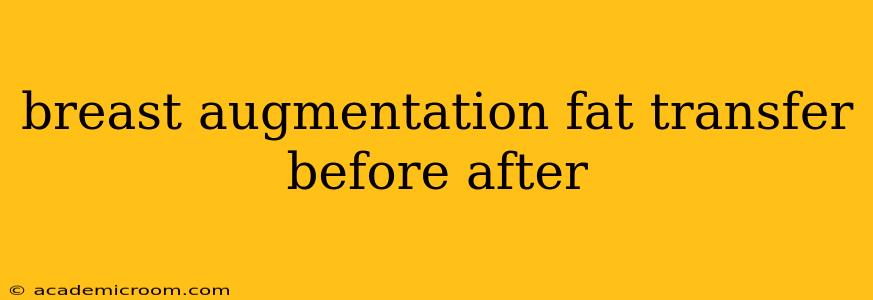Breast augmentation using fat transfer, also known as autologous fat grafting or lipofilling, is a popular procedure offering a natural-looking breast enhancement. Unlike traditional breast implants, this technique uses the patient's own fat to augment the breasts, resulting in a softer, more natural feel and appearance. However, understanding the before and after aspects is crucial for realistic expectations. This comprehensive guide delves into the process, potential results, and frequently asked questions.
What Does Breast Augmentation with Fat Transfer Involve?
The procedure typically begins with liposuction to harvest fat from areas like the abdomen, thighs, or hips. This fat is then processed to remove impurities and concentrate the viable fat cells. The purified fat is then carefully injected into the breasts using specialized cannulas to achieve the desired shape and volume. Multiple injections are often necessary to ensure optimal results and even distribution. The entire process can take several hours, depending on the amount of fat transferred and the desired outcome.
What are the Before and After Results Like?
Before: Before the procedure, you'll have a consultation with a plastic surgeon to discuss your goals, assess your suitability, and determine the amount of fat needed. Photographs will be taken to document your baseline.
After: Immediately after the procedure, you may experience some swelling, bruising, and discomfort. These are temporary and usually subside within a few weeks. You'll need to wear a compression garment to minimize swelling and support the breasts. The final results are usually visible after several months, as some fat cells will be reabsorbed by the body. The surgeon will schedule follow-up appointments to monitor your progress. It's important to remember that not all transferred fat will survive; typically, around 60-70% will be retained long-term. This means you might need more than one procedure to reach your desired breast size and shape.
How Long Does It Take to See Results?
The full results of a fat transfer breast augmentation are typically visible after 3-6 months. This is because the body needs time to reabsorb excess fluid and for the transferred fat cells to fully integrate. Initial swelling and bruising will resolve much sooner, usually within a few weeks. Multiple procedures might be needed to achieve the desired outcome, as the percentage of fat cells that survive can vary between patients and procedures.
What is the Recovery Process Like?
Recovery time varies depending on the individual and the extent of the procedure. You can expect some discomfort, swelling, and bruising in the areas where fat was harvested and injected. Your surgeon will provide post-operative instructions, including pain management, and recommendations for activity levels. Light activity can usually resume after a week, but strenuous exercise should be avoided for several weeks. It's crucial to follow your surgeon's post-operative care instructions diligently.
Are There Any Risks Associated with Fat Transfer Breast Augmentation?
Like any surgical procedure, fat transfer breast augmentation carries potential risks. These include:
- Fat necrosis: Death of fat cells, leading to lumps or irregularities.
- Infection: Infection at the injection or harvesting sites.
- Fluid collection (seroma): Accumulation of fluid in the breasts.
- Asymmetry: Uneven breast size or shape.
- Unsatisfactory results: The need for revision surgery.
What are the Long-Term Results?
The longevity of results varies between individuals. While the majority of transferred fat cells will survive, some fat reabsorption is expected. Maintaining a stable weight after the procedure is crucial for preserving long-term results.
Is Fat Transfer Breast Augmentation Right for Me?
This procedure is ideal for individuals seeking a subtle breast augmentation with a natural look and feel. It’s particularly suitable for patients with sufficient fat deposits in other areas of their bodies. However, it's important to have a thorough consultation with a qualified plastic surgeon to discuss your goals, assess your suitability, and understand the potential risks and benefits. The surgeon will help you determine if this procedure aligns with your expectations and overall health.
What is the Cost of Fat Transfer Breast Augmentation?
The cost varies depending on several factors, including the surgeon's fees, anesthesia costs, facility fees, and the extent of the procedure. It is essential to discuss the total cost with your surgeon before proceeding. Remember to factor in potential costs associated with follow-up appointments or revision surgeries.
This information is intended for educational purposes only and does not constitute medical advice. Always consult with a qualified healthcare professional for any health concerns or before making any decisions related to your health or treatment.
